高一英语上册全册教案
- 格式:doc
- 大小:222.50 KB
- 文档页数:52
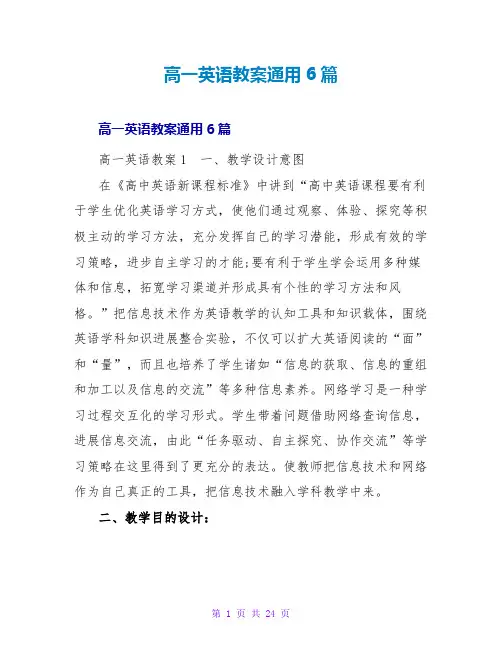
高一英语教案通用6篇高一英语教案通用6篇高一英语教案1 一、教学设计意图在《高中英语新课程标准》中讲到“高中英语课程要有利于学生优化英语学习方式,使他们通过观察、体验、探究等积极主动的学习方法,充分发挥自己的学习潜能,形成有效的学习策略,进步自主学习的才能;要有利于学生学会运用多种媒体和信息,拓宽学习渠道并形成具有个性的学习方法和风格。
”把信息技术作为英语教学的认知工具和知识载体,围绕英语学科知识进展整合实验,不仅可以扩大英语阅读的“面”和“量”,而且也培养了学生诸如“信息的获取、信息的重组和加工以及信息的交流”等多种信息素养。
网络学习是一种学习过程交互化的学习形式。
学生带着问题借助网络查询信息,进展信息交流,由此“任务驱动、自主探究、协作交流”等学习策略在这里得到了更充分的表达。
使教师把信息技术和网络作为自己真正的工具,把信息技术融入学科教学中来。
二、教学目的设计:知识与技能:①掌握快速阅读的方法,熟悉“发表看法,提出建议”的口语技能。
②充分利用网络资,强化学生自主学习的意识,培养学生组织语言、运用语言的才能。
过程与方法:①培养学生挑选局部和整体信息的才能和独立阅读才能,通过自主学习和协作学习,获取信息和处理信息的才能。
②培养学生质疑意识,分析^p 问题、解决问题、综合问题的才能和创造性思维才能。
情感价值观:通过本节课的学习,培养学生的人文和信息素养。
三、教材内容及重点、难点分析^p :教材内容:本课教学内容是新课标《高中英语必修3 Unit 5》,Canada---The True North 与以往接触过的介绍国家的文章相比,本课的内容没有整体介绍____的地理概况和风土人情,而是透过一个旅人的眼睛来看____。
相比较而言,这样的课文难度更大。
教学重点:①对课文内容的整体把握。
②学生组织语言、运用语言的才能。
【重点打破】任务驱动,层层深化。
利用“任务驱动”方法,使学生利用资自主探究、解决一系列层层深化的问题。
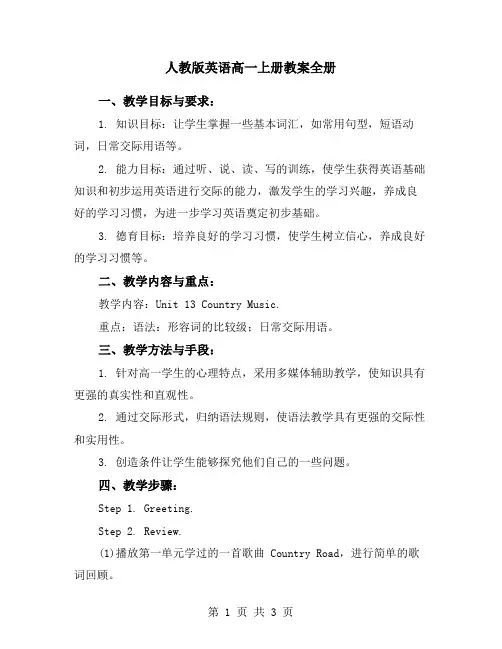
人教版英语高一上册教案全册一、教学目标与要求:1. 知识目标:让学生掌握一些基本词汇,如常用句型,短语动词,日常交际用语等。
2. 能力目标:通过听、说、读、写的训练,使学生获得英语基础知识和初步运用英语进行交际的能力,激发学生的学习兴趣,养成良好的学习习惯,为进一步学习英语奠定初步基础。
3. 德育目标:培养良好的学习习惯,使学生树立信心,养成良好的学习习惯等。
二、教学内容与重点:教学内容:Unit 13 Country Music.重点:语法:形容词的比较级;日常交际用语。
三、教学方法与手段:1. 针对高一学生的心理特点,采用多媒体辅助教学,使知识具有更强的真实性和直观性。
2. 通过交际形式,归纳语法规则,使语法教学具有更强的交际性和实用性。
3. 创造条件让学生能够探究他们自己的一些问题。
四、教学步骤:Step 1. Greeting.Step 2. Review.(1)播放第一单元学过的一首歌曲 Country Road,进行简单的歌词回顾。
(2)让学生复述单元单词和短语。
(3)单元重点句型的口头复述。
设计意图:通过复习歌曲和句型,调动学生的学习热情和积极性,并引入本单元话题。
Step 3. Presentation.(1)展示几个形容词(如:biggest, oldest, longest等),介绍其比较级形式并示范发音,让学生自己读,老师板书在黑板上,然后让学生练习巩固。
(2)再展示另外一些形容词的比较级形式,让学生根据发音规则自己拼读,发现不规则的单词自己试着记忆。
接着老师和学生一起总结规则变化。
学生自主学习为主,然后到黑板上听写单词,最后大家一起检查更正。
(3)看图用形容词比较级造句,学生两人一组进行操练。
(4)小组活动:用比较级造句并讨论班上谁是最高的、最胖的、最年轻的等。
(5)介绍Country Music的起源、风格及介绍一首歌曲的演唱者等。
设计意图:通过示范、归纳和大量的口头练习,使学生进一步掌握形容词的比较级用法。
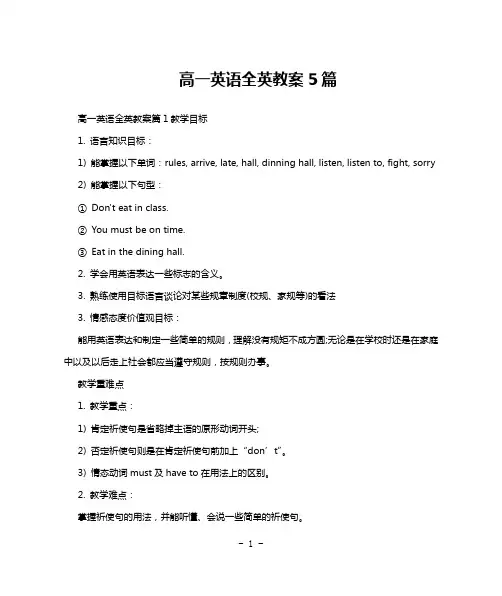
高一英语全英教案5篇高一英语全英教案篇1教学目标1. 语言知识目标:1) 能掌握以下单词:rules, arrive, late, hall, dinning hall, listen, listen to, fight, sorry2) 能掌握以下句型:①Don't eat in class.②You must be on time.③Eat in the dining hall.2. 学会用英语表达一些标志的含义。
3. 熟练使用目标语言谈论对某些规章制度(校规、家规等)的看法3. 情感态度价值观目标:能用英语表达和制定一些简单的规则,理解没有规矩不成方圆;无论是在学校时还是在家庭中以及以后走上社会都应当遵守规则,按规则办事。
教学重难点1. 教学重点:1) 肯定祈使句是省略掉主语的原形动词开头;2) 否定祈使句则是在肯定祈使句前加上“don’t”。
3) 情态动词must及have to在用法上的区别。
2. 教学难点:掌握祈使句的用法,并能听懂、会说一些简单的祈使句。
多媒体教学过程Ⅰ. Warming-up and revision教师进教室后,使用祈使句请学生们完成一系列动作:Please stand up/ sit down. Close the door, please. Look at me and listen to me.Don’t open your books. Don’t talk. Let’s begin our class.学生听教师的指令完成各种动作,教师也可将指令写到黑板上,让学生从视觉上考察祈使句的特点。
Ⅱ. Presentation教师出示书上1a 的图片,向学生提问。
指着图上奔跑的男孩提问T:What’s the boy doing? S: He’s running.T: Where is he running? S: He’s running in the hallways.(板书,教读)T:Can you run in the hallways? S: No, I can’t.T: So please don’t run in the hallways.(板书,教读)(= You can’t run in the hallways.)学生跟读数遍,明白祈使句和“can”的表达含意。
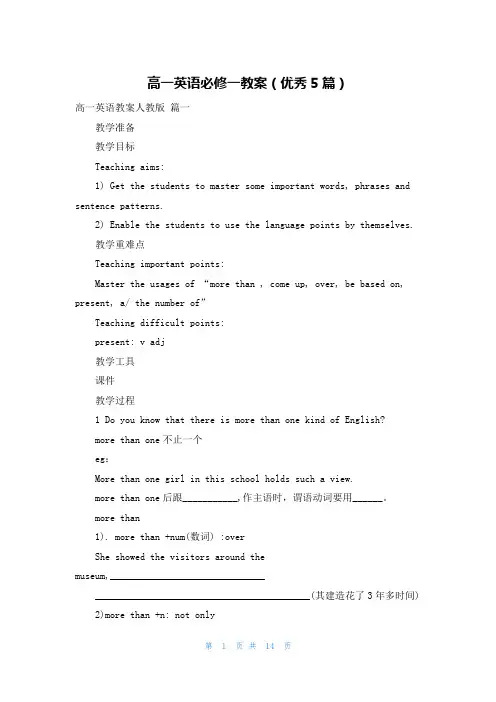
高一英语必修一教案(优秀5篇)高一英语教案人教版篇一教学准备教学目标Teaching aims:1) Get the students to master some important words, phrases and sentence patterns.2) Enable the students to use the language points by themselves.教学重难点Teaching important points:Master the usages of “more than , come up, over, be based on, present, a/ the number of”Teaching difficult points:present: v adj教学工具课件教学过程1 Do you know that there is more than one kind of English?more than one不止一个eg:More than one girl in this school holds such a view.more than one后跟___________,作主语时,谓语动词要用______。
more than1). more than +num(数词) :overShe showed the visitors around themuseum,__________________________________________________________________________(其建造花了3年多时间) 2)more than +n: not onlyMusic is more than just a sound--- it’s a way of thin king.3) more than +adj/v : very听到这个消息我很高兴。
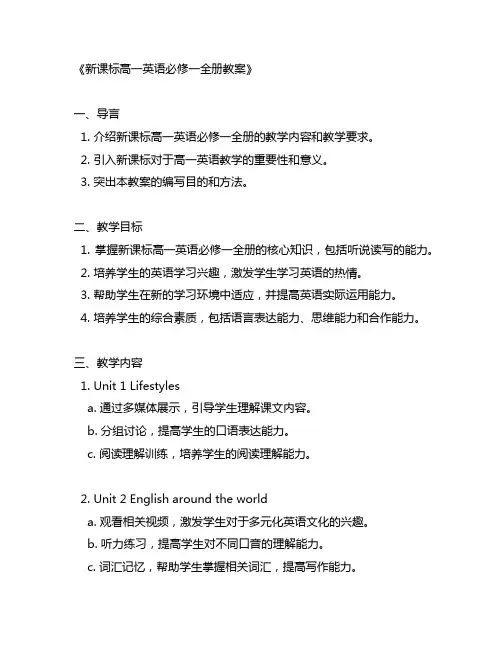
《新课标高一英语必修一全册教案》一、导言1. 介绍新课标高一英语必修一全册的教学内容和教学要求。
2. 引入新课标对于高一英语教学的重要性和意义。
3. 突出本教案的编写目的和方法。
二、教学目标1. 掌握新课标高一英语必修一全册的核心知识,包括听说读写的能力。
2. 培养学生的英语学习兴趣,激发学生学习英语的热情。
3. 帮助学生在新的学习环境中适应,并提高英语实际运用能力。
4. 培养学生的综合素质,包括语言表达能力、思维能力和合作能力。
三、教学内容1. Unit 1 Lifestylesa. 通过多媒体展示,引导学生理解课文内容。
b. 分组讨论,提高学生的口语表达能力。
c. 阅读理解训练,培养学生的阅读理解能力。
2. Unit 2 English around the worlda. 观看相关视频,激发学生对于多元化英语文化的兴趣。
b. 听力练习,提高学生对不同口音的理解能力。
c. 词汇记忆,帮助学生掌握相关词汇,提高写作能力。
3. Unit 3 Travel journala. 语法练习,巩固学生的语法知识。
b. 听力训练,提高学生的听力理解能力。
4. Unit 4 Wildlife protectiona. 观看相关纪录片,引导学生对于野生动物保护问题的思考。
b. 语言实践,激发学生表达观点的能力。
c. 课外阅读,拓展学生知识面,提高综合素质。
5. Unit 5 First aida. 观看教学视频,学习急救知识和技能。
b. 分角色扮演,培养学生的合作意识和团队精神。
c. 讨论交流,引导学生学会在紧急情况下正确表达和沟通。
6. Unit 6 Languagea. 语言点讲解,帮助学生理解和掌握语言的规则与用法。
b. 语言实践,激发学生运用所学语言进行交流。
7. Unit 7 The world of worka. 制定职业规划,帮助学生了解不同职业的本质和发展前景。
b. 个人陈述,提高学生的自我表达能力。
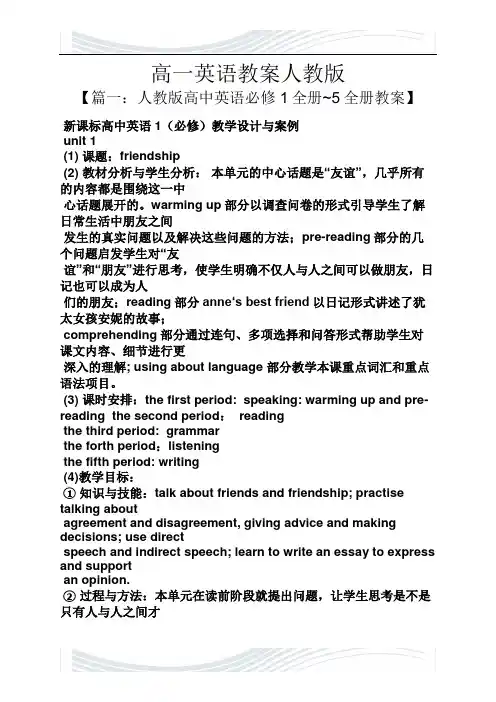
高一英语教案人教版【篇一:人教版高中英语必修1全册~5全册教案】新课标高中英语1(必修)教学设计与案例unit 1(1) 课题:friendship(2) 教材分析与学生分析:本单元的中心话题是“友谊”,几乎所有的内容都是围绕这一中心话题展开的。
warming up部分以调查问卷的形式引导学生了解日常生活中朋友之间发生的真实问题以及解决这些问题的方法;pre-reading部分的几个问题启发学生对“友谊”和“朋友”进行思考,使学生明确不仅人与人之间可以做朋友,日记也可以成为人们的朋友;reading部分anne‘s best friend以日记形式讲述了犹太女孩安妮的故事;comprehending部分通过连句、多项选择和问答形式帮助学生对课文内容、细节进行更深入的理解; using about language 部分教学本课重点词汇和重点语法项目。
(3) 课时安排:the first period: speaking: warming up and pre-reading the second period: readingthe third period: grammarthe forth period:listeningthe fifth period: writing(4)教学目标:①知识与技能:talk about friends and friendship; practise talking aboutagreement and disagreement, giving advice and making decisions; use directspeech and indirect speech; learn to write an essay to express and supportan opinion.②过程与方法:本单元在读前阶段就提出问题,让学生思考是不是只有人与人之间才能交朋友,然后在阅读中通过安妮的日记向学生说明我们也可以与动物及无生命的日记交朋友。
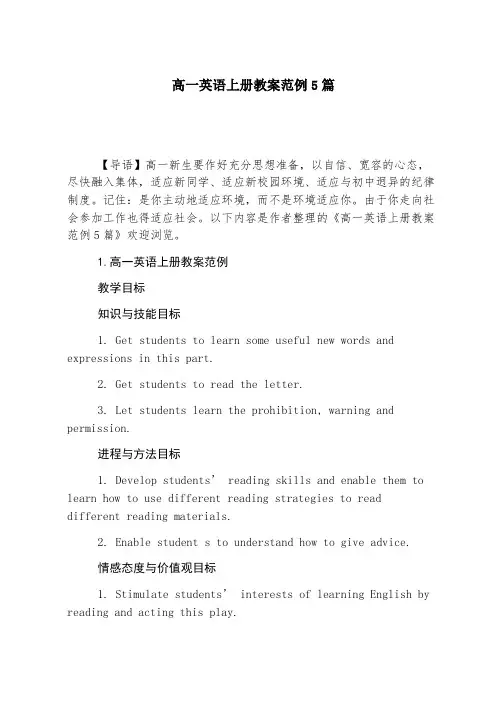
高一英语上册教案范例5篇【导语】高一新生要作好充分思想准备,以自信、宽容的心态,尽快融入集体,适应新同学、适应新校园环境、适应与初中迥异的纪律制度。
记住:是你主动地适应环境,而不是环境适应你。
由于你走向社会参加工作也得适应社会。
以下内容是作者整理的《高一英语上册教案范例5篇》欢迎浏览。
1.高一英语上册教案范例教学目标知识与技能目标1. Get students to learn some useful new words and expressions in this part.2. Get students to read the letter.3. Let students learn the prohibition, warning and permission.进程与方法目标1. Develop students’ reading skills and enable them to learn how to use different reading strategies to read different reading materials.2. Enable student s to understand how to give advice.情感态度与价值观目标1. Stimulate students’ interests of learning English by reading and acting this play.2. Develop students’ sense of group cooperation and teamwork.教学重点1.state the main idea of each paragraph in own words2.ways to become addicted to cigarettes3.the harmful effects of smoking4. suggestions to quit smoking教学难点1. sorting out major idea and minor idea2. master key words in key sentence教学进程→Step 1 Warming upShow some proverbs on health1.An apple a day keeps the doctor away.2.Early to bed and early to rise, makes a man healthy, wealthy and wise.→Step 2 Skimming1.How many parts does the reading text consist of?2. Who wrote the letter to whom?3. How many ways can a man become addicted to smoking?2.高一英语上册教案范例一、教学内容分析本单元的中心话题是西方绘画艺术的历史和中西方各种艺术情势和风格。

高一上英语教案8篇(经典版)编制人:__________________审核人:__________________审批人:__________________编制单位:__________________编制时间:____年____月____日序言下载提示:该文档是本店铺精心编制而成的,希望大家下载后,能够帮助大家解决实际问题。
文档下载后可定制修改,请根据实际需要进行调整和使用,谢谢!并且,本店铺为大家提供各种类型的经典范文,如工作计划、工作总结、条据文书、合同协议、规章制度、应急预案、心得体会、教学资料、作文大全、其他范文等等,想了解不同范文格式和写法,敬请关注!Download tips: This document is carefully compiled by this editor. I hope that after you download it, it can help you solve practical problems. The document can be customized and modified after downloading, please adjust and use it according to actual needs, thank you!Moreover, our store provides various types of classic sample essays for everyone, such as work plans, work summaries, policy documents, contract agreements, rules and regulations, emergency plans, reflections, teaching materials, essay summaries, and other sample essays. If you want to learn about different sample essay formats and writing methods, please stay tuned!高一上英语教案8篇只有通过认真写教案,我们才能够更好地规划教学资源的使用,提高教学的有效性和经济性,为了提高我们的教学质量,我们很有必要认真准备好详细的教案,以下是本店铺精心为您推荐的高一上英语教案8篇,供大家参考。
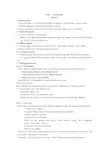
Unit 1 Good friendsPeriod 1I. Teaching aims:1. Learn to describe a friend or describe oneself to others. Let students know what a friend is.2. Study the language points connected with the dialogue.3. New words: honest, brave, loyal, wise, handsome, smart, argue, classical, fond (of).II. Important points:1.Train the Students’ listening ability.2.Master the new phrase and sentence pattern and make the students be free to talk about names,ages, ho bbies, likes and dislikes, etc.III. Difficult points:1. Learn the usage of the sentences pattern: So/ Nor + link /model/ auxiliary verb + subject2. Improve the students’ listening and speaking ability.IV. Teaching methods1 . Listening-and–answering activity to help the students go through with the listening material.2. Use both individual work and group or pair work to make every student work and think in class.V. Teaching procedures:Step 1 Presentation1. Greet with the students and have them guess the exact Chinese meaning of the proverb.A life without a friend is a life without the sun.A man who has friends must show himself friendly..A friend in need is a friend indeed.2. Start with the following questions, and teach some new words.Do you like friends?How many kinds of friends are there in your opinion? What kind of friends do you prefer?Can you describe one of your friends to us?kind, funny, strong, richhonest, brave, loyal, wise, handsome, smart(helpful, lovely, careful, silent, talkative, unselfish, generous, hardworking, diligent)Step 2 Pair work1 Books open. Go through the dialogue with the students and make sure they understand it fully.1. should--shall, ought toYou should study harder. My teacher said I should study harder.2.quality--qualities, quantity3.describe +n./n. to sb./clauseWords can not describe her beauty. Please describe exactly wh at happened.4.loyal--more/ most ~ +to sb.He wanted to be loyal to his friend.Then tell the students:Now please work in pairs and try to describe one of your friends or yourself to your partner. You can use the words listed in Warming up.2 Listening:Listen carefully to the tape. Then work in pairs and check the answers.Step 3 DemonstrationAsk several students to describe a friend and give necessary hints and encouraging remarks.Step 4 DefinitionFrom what you described, we know what a friend is. A friend is someone who… Different people have different friends, but people who share the same interests, hobbies and characteristics may become people easily.Step 5 Speaking1.N ow let’s move to the next part, speaking. Please read the instructions first and then work in pairs and decide who can be friends and give your reasons,Now I’ll check how well you have worked. Tell me who and why? You can express your ideas with the patterns in the following box.I’m sure…I guess…Perhaps……are probably…List for ages gender likes and dislikes.Name John Steve Peter Ann Sarah Joe Age 15 14 15 16 14Gender boy boy boy girl girl boyLikes footballreadingskiingreadingsingingsingingrock musiccomputerdancingcomputersrock musicreadingfootballsingingcomputersrock musicskiingDislikessingingcomputershikingrock musicfootballfootballclassicalmusicdancinghikingclassicalmusicreadingrock musicdancingcomputersfootballhiking2.Notes1.especially--speciallyThe tree is beautiful, ~in autumn.--I came here ~ to ask you a question.2.into--inHe is into rock music. He grew into a man. She is in good shape.3.be fond of +n./ doing sth. =like4.My interests are reading. S+V+P—They are reading. S+V5….nor do I… (P157)HomeworkFinish off the exercises in the Wb.Period 2I. Teaching aims:1.Read and understand how Chuck survives on the island and know more about what a friend means.2.Improve reading ability and study the language points connected with the text.New words: match, mirror, fry, gun, hammer, saw, rope, movie, cast, deserted, hunt for, in order to, share, sorrow, care about, feeling, such as, airplane.II. Important points:1. Train the Students’ reading ability.2. Master the new phrases and wordsIII. Difficult points:How to make the students understand the reading text better.IV. Teaching method1 . Fast reading fro the students get the general idea first.2. Discuss after reading to understand the text berrer.3. Careful reading to get the detailed information.V. Teaching procedures::Step 1 Lead-inHave you ever read Robinson Crusoe ? The story tells about how Robinson Crusoe survived on an island after his boat met with a storm. Today we are going to learn a similar story about Chuck Noland. Chuck’s plane crashes on a deserted island, but he was able to survive there alone. During his stay on the island he made a special friend.Step 2 Pre-readingGo through the pre-reading with the students and make sure the students can choose the three items which they think are the most useful. Check their work, referring to the following samples.1. a box of matches…make a fire, cook some food, frighten the animals at night with a fire lit with a match, let others know where I am2.a knife…protect myself from being attacked by wild animals, cut some trees for fruit, cut wood for fire, cut food into small pieces3.a frying pan… cook food, co llect the rain waterStep 3 Fast readingRead the story quickly and do the true or false questions.1.Chuck is a businessman working in a company. T2.Chuck is one of the people who survive the plane crash. F3.Collecting water and hunting for food are all Chuck has to learn on the island. T4.Chuck makes some friends there one of whom is Wilson, a football. F5.Staying on the island helps Chuck realize his shortcomings. T6.In Chu ck’s opinion, people make friends to share happiness and sorrow. T7.Wilson is fond of Chuck because he is well cared for by him. F8.Chuck thinks friends are teachers, for they teach people everything. F9.Friends can be animals and even things as well as human beings. TStep 4 Careful readingRead again and find the topic sentences of each paragraph.1.Chuck’s plane lands on a deserted island.2.Chuck has to learn to how to survive on the island.3.Chuck learns a lot about himself when he is alone on the island.4.Chuck has made an unusual friend on the island.Deal with some language points in the textDiscuss the questions in Post-reading in group of four: one or two groups will be asked to do a report about their discussion.Step 5 RetellingRetell the story according to the hinds:.plane crashed, deserted island, .learned to, made friends with, realized, learnt, the lesson from ChuckHomeworkFinish off the exercises in the Wb.Period 3I. Teaching aims:1. Review the words and phrases in the last two periods.2. Learn and master the direct and indirect speech.3. New words: lie, speech, adventure, notebook.II. Important points:1. Master the interchanges of direct speech and indirect speech in the declarative sentences and interrogative sentence.2. Guess the missing word according to the context.III. Difficult points:Different changes of pronouns, tenses, adverbials in the interchanges of direct speech and indirect speech.IV. Teaching methods1 .Review method.2. Explanation and inductive methods to teach them grammar.3. Individual and pair work to make each of them work in class.V. Teaching procedures:Step 1 Lead-inCheck students’ homework. Ask one or two students to share his story ab out Chuck with the classmates. Give the students necessary courage and remarks.Step 2 Word studyAsk the students to do the exercises individually and them check answers with them.1.honest2.classical3.sorrow4.argue5.loyal6.hunt for7.fond of8.brave9.in order to 10.smart Explain the language points to the students:1.keep饲养as作为,当作We keep a dog.He has a large family to keep.2.regard+n.+as+n.regard+n.+with+n.用某种眼光看待They regarded his attitude with suspicion.Step 3 GrammarGo through the examples of Direct speech and Indirect speech on page 5 of the textbook.More explanations about Direct speech and Indirect speech☆直接引语变间接引语, 人称,时态,指示代词,时间地点状语应作相应改变.1.直接引语为陈述句, 间接引语变从属连词引导的宾语从句.The boy said: “I am not afraid to meet strangers *now.”The boy said that he was not afraid to meet strangers *then.2.直接引语为一般疑问句, 间接引语变从属连词引导的宾语从句.She asked: “Have you seen the movie?”She asked me weather/if I had seen the movie. (weather…or not)3.直接引语为特殊疑问句The man asked: “Which room do you prefer?”The man asked me which room I preferred.4.直接引语为祈使句, 间接引语常构成简单句型ask/tell/order/advise/warn/remind/etc. + n./pron. + (not) to do sth.“Don’t make a mess in the room,” she said to the child.She asked/told/warned the child not to make a mess in the room.5. The adverbials usually change as following:today that dayyesterday the day beforetomorrow the next daynext month/week the next month/weeklast week/year the week/year beforeago beforetwo years ago two years beforenow thenhere thereso far by thenin 2002 in 2002Step 4 PracticeAsk the students to finish part 2 of grammar on page 5. Check the work afterwards.HomeworkFinish off the exercises in grammar part in the Wb.Period 4I. Teaching aims:1.Review the language points in the unit.2.Finish reading and writing.3.Learn how to write an e-mail..II. Important points:1. Train the Students’ writing ability.2. Tell them the way of getting communicated with others in e-mail.III. Difficult point:Impro ve the students’ intergrating skills.IV. Teaching methods1 .Asking-and –answering activity to go through the reading material.l.2. Individual and pair work.V. Teaching procedures:Step 1 Lead-inAsk the students the following questions.1.Do you have friends in the Internet?2.How often do you write to your e-pal?3.Which do you prefer, a pen friend, a friend in the Internet or in real life? Why? Tell them what we are going to learn is about email.Step 2 ReadingGo through the two e-mails on page 7 of the text book.Language focus:1.joke around—joke about v.play a ~ on, make a ~, tell jokes n.I joked with her.2.fun 〔U〕n.玩笑,娱乐,乐趣He is full of fun.I did it just for fun.They often make fun of her.3.drop 落下,掉落Drop me a line. 写封短信给我.He dropped his voice. 放低He dropped into a chair. 坐The wind has dropped. 减弱Step 3 WritingAsk the students: Who do you want to reply to, Jane or Jack? Why?Write an e-mail after discussion.Check their work.Step 4 ConclusionGo through the Checkpoint about direct speech and indirect speech.Go over the language points in the unit and summarize the uses of direct speech and indirect speech.HomeworkFinish off the exercises in the Wb.Revise the grammar and useful expressions in the unit.Unit 2 English Around the WorldPeriod 1I. Teaching aims:1. Train the Ss’ ability of speaking and listening2. Learn about the differences American English and British English3. Learn how to make an order or a requestII. Important points:1.How to help the students’ listening ability.2.Lear about sentence transformation.III. Difficult point:How to use different sentence p atterns to express one’s idea.IV. Teaching methods:1. Listening practice to improve the students’ listening ability.2. Discussion method to give them more chances to express their own ideas.V. Teaching procedures:Step l presentationAsk the Ss some questions about English and let them have a general idea about the question:1.Is English very popular?2.In which country do people speak English as their mother language?3.In which country do people speak English as their second language?4.Ate the American English and the British English the same?5.What are the differences between them?Step 2 Warming up1.Look at the picture and ask the question:What does bathroom mean in American English and British English?2.Read the dialogue in the and text and answer the question: in AmericanEnglish, it means “toilet” and in British English it means “a place for some people to take a shower”3.Ask more questions about the dialogue:●Where did Joe come from?●How did he reach London?●Did he have a good sleep?●Why did Nancy give Joe a new towel?●Where is the bathroom?●What did Joe actually want?Step 3 PracticeRead and act out the dialogue then introduce some more words that have different meaning in the two languages.billion=one million millions (BE) one thousand million (AE)public school=private school (BE)local state school providing free education (AE)Step 4 ListeningLet the Ss listen to two different passages which are read in BE and AE and tell them the two languages are quite different in pronunciation Then practice the dialogue “kilometer” and tell them this word has two different spelling and also two different pronunciations.Step 5 ListeningListen carefully to the tape. Mr Brown’s landlady has many house rules. Write down five of them..Step 6 GrammarDirect and indirect speechesSb. asked / told sb. (not) to do sth.Change the following sentences into indirect speech:1. “Get up early Tony. You’ll be late for class.” His mother said to him.2. “Don’ t disturb the sleeping baby.” Mary said.3. “Put away all the unnecessary articles,” the housekeeper said rudely.4.“Don’ t cross the road without looking around.” The policeman said kindly to theboy.Step 7 Speaking1. Practise the dialogue one in the text and ask the Ss to finish the exercise.2. Questions for dialogue two.(1) What did Ms Smith ask Harry to do?(2) What did Harry ask Mw Smith to do?(3) And what did Harry ask Ms smith to do again?(4) What did Ms Smith tell Harry not to do?3. Ask the Ss to read aloud the dialogue and then ask them to repeat the di alogue.Rewrite the following sentences:1. My mother told me not to believe a stranger easily.(direct speech)2. The principle asked the Ss to wash their clothes by themselves.(direct speech)3.“Don’t throw away the leftovers. It’s too a waste of food.” T he owner said to his customers.(indirect speech)4.“I am going to Japan tomorrow. I have asked for a leave of six months.” Jerky said to her colleagues.(indirect speech)Period 2I. Teaching aims:1. Train the Ss’ ability of reading.2. Learn about English around the world.3. Listen and repeat the text.II. Important point:How to get the students to master the useful words and expressions:majority, native, equal, except, , in total, situation, organization, international, etc.III. Difficult point:Get full understanding of the whole as well as the details.IV. Teaching methods:1. Fast-reading to train the students’ reading ability.2. Reading comprehension to help the students to grasp the main idea of the text.3. Practise getting the students to master what they have learned.V. Teaching procedures:Step 1 RevisionGo over the dialogue by asking the Ss to read aloud their composition and ask them to rewrite more sentences.Step 2 Pre-discussionDiscuss the following pre-reading questions:1. If you speak more than one language, in what situations do you use the language?2. Why do we have to learn English?Step 3 Fast readingRead the text fast and answer :Why will it be more and more important to have a good knowledge of English? (Because many people communicate in English every day.)Step 4 Careful readingAsk the students to read more carefully and answer the post-reading questions 2-3.Step 5 SummarySummarize main ideas of each paragraph of the text.Paragraph 1 English is spoken as mother tongue and as a second language.Paragraph 2 Many people learn English as a foreign language.Paragraph 3 Many people communicate in English every day.Step 6 ListeningListen to the tape of the text and do the post-reading exercise 2, filling the blanks.Step 7 DiscussionDiscuss the following topics in groups of four for about 4 minutes, then ask the representative of each group to present their reasons in the front.1. Why do so many people speak English?2. Will Chinese mandarin be popular one day?3. Why Cantonese is so popular in China?HomeworkGo over what we have learned in this reading text.Period 3I. Teaching aims:1. Learn the useful words and phrases in the text.2. Learn the difficult sentences.3. Learn the grammar: direct and indirect speeches.II. Important points:the direct and indirect speechesIII. Difficult points:How to use ask/tell/ order sb. to do sth. to report an order or request.IV. Teaching methods:1. Inductive method to get the students to think more by themselves.2. deductive method when teaching the Indirect Speech.V. Teaching process:Step 1 RevisionListen and read the text.Step 2 Word studyThe teacher can read the explanation for the Ss and ask them to guess the new words. Step 3 Language pointsPick out some difficult sentences for the students to analyze and explain new words and expressions to the students if they have difficulty in understanding them. Phrases: all around the world, in total, at high school, except for/except, on the radio/ on the phone, through the Internet, a good knowledge of , majority, leave the door open, mother tongueuseful sentences:1. There are more than 42 countries where the majority of the people speakEnglish.2. In total, for more than 375 million people English is their mother tongue.3. In China students learn English at schools as a foreign language, except forthose in Hong Kong.4. Chinese businessmen, taxi drivers and students talk with them using English.5. With so many people communication in English every day, we can see that itwill be more important to have a good knowledge of English.Step 4 GrammarLearn which is an order and which is a request:Sentences for a request may begin with: could I/Will you/May I. Sentences for an order may be without subjects. If the sentences are changed into indirect speech, “asked” means a request, “told” means an order. Show them some examples to make them clear about how to change an order or request into indirect speech. The following are some examples for the students to practice:1. Change the following sentences into indirect speech:(1) Could I use your bathroom for a moment? (he, his friend)(2) Put your coat in the closet. (they, the little boy)(3) Speak quietly on the closet. (the teacher, his colleague)(4) Will you help me with my homework this afternoon? (John , me)(5) Could you meet me at four? (Mary, her husband)2. Change the following sentences into direct speech:(1) The landlady asked him to put his coat in the closet.(2) The landlady asked him not to put it on the peg.(3) The commander ordered the soldiers to stand still.(4) The commander ordered the soldiers not to move.(5) Mother told me to lock the door after not to move.3. Work in pairs. First report the orders, using “she told us (not)-” Then repo rt therequests, using “he asked us (not)-”(1) She told us to buy some bread for her.(2) She told us not make too much noise.(3) She told us to help her tidy the room.(4) She told us not to forget to put your umbrella in the stand.(5) He asked us to speak quietly on the phone.4. Group workThe teacher read some more sentences for the Ss to change into an order (she told us)or a request (she asked us):(1)go to bed immediately (an order)(2)not to throw away the used paper(a request)(3)lend him several books (a request)(4)redo his homework (an order)(5)not to disturb his father(an order)Step 6 PracticeMake more sentences using “with + n. +doing / done / to do / prep.” after the model.Model:With so many people communication in English every day , we can see th at it will be more and more important to have a good knowledge of English.1. This room is extremely cold the window .2. so much work , he may not be here.3. so many trees and flowers , the classroom looks wonderful.4.He is getting on well with his work his mother him. Homework:Go over what we have learned about direct and indirect speech.Period 4I. Teaching aims:1. Learn the reading text to know the differences between American English and British English.2. Teach the students some useful words and expressions of the text.II. Important points:1.Improve the students’ reading ability by reading the text.2.Improve their writing skills.3.Know more about American and British English.III. Difficult points:Practise writing and improve writing skills.IV. Teaching methods:1. Practise makes better skills.2. Fast reading and pair work or group work to get students active in class.V. Teaching procedures:Step 1 RevisionTalk about their compositions and revise the direct and indirect speeches for and order or for a request.Ask the Ss to translate some Chinese sentences into English to go over the phrases and some useful words:(1)all over the world(2)on the radio(3)in total(4)except for(5)have a good knowledgeStep 2 PresentationWe have learned the word “bathroom” has different meaning in BE and AE. Now tell me the different meaning(toilet or a place for a shower)Today we’ll learn something more about their differences. Read quickly and try to tell me , from which year did AE and BE become different?(1776)Step 3 Fast readingRead carefully and answer the following questions.1.Was the language in Britain and America the same at first?2.When did America become an independent country?3.Where did the language stay the same, in Britain or in America?4.Why do Americans talk “autumn” for “fall”?5.Where is the English word “typhoon” form? And how about the Americanword “tornado”?6.Who wrote the first American dictionary? And when? Why did he change thespelling?7.Which is greater, the difference in the spoken English or in the writtenEnglish?8.Do people from the two countries have any difficulties in understanding eachother?Step 5 ListeningListen to the tape and finish the exercise in the text.Step 6 Reading and SpeakingAsk the Ss to read the text and talk about the differences in their own words and get them to tell the reasons for differences.Step 7 PracticeRead the passage again and complete the chart:Words Borrowed fromCentFloridaHowlcookbookSuggested answerscent-old French Florida-Spanish howl-American Indian cookbook-GermanHomeworkThe Ss are required to read the tips and write a short passage to compare dialects in Chinese.Unit 3 Going placesPeriod 1I. Teaching Aims:1. Learn and master the following words: traveling, transportation, consider, boarding call,destination.2. Do some listening.3. Do some speaking and talk about traveling to the past or future.II. Important Points:1. Improve the students' listening ability.2. Improve the students' speaking ability by discussion, talks and making some dialogues.III. Difficult Points:How to finish the task of speaking and how to make dialogues correctly.IV. Teaching methods1.Warming up to arouse the students’ interest in travelin g.2.Listening activity to improve the students’ listening ability.3.Get as many activities as possible for the students to get more chances to practice.V. Teaching Procedures:Step Ⅰ. GreetingsGreet the class as usual.Step 2 Lead inT: With the development of society, we are changing our way of life. More and more people like to travel. Do you often travel? Where have you been?What should you do when you are traveling?Collect the answers:bring the things we need think about our safetytravel with other people in the mountain or in the forestthrow waste things in the dustbins park cars in parking plotsStep 2 Warming upAsk the students to open their books at Page 15 and look at the four pictures in it. Discuss in pairs and see if the people in the pictures are doing anything wrong. After a while, teacher asks at least four students to talk about the pictures before the class.(Picture 1) The man is driving too fast. He should drive at the speed of 30 km an hour, but he is driving at 60 km per hour.(Picture 2) The woman is littering waste things. She is going outing in the mountain. She shouldn't throw rubbish where there is a sign, saying "No littering!".(Picture 3) The man is in the park. He shouldn't be smoking in the place where there is a sign, saying "No Smoking!".(Picture 4) The car is stopping at the wrong place. There is a sign, saying "No parking!"For Ex. 2, tell the students that "Means of transportation" refers to the ways of carrying people or goods from one place to another and "consider" means "think about".Ask: Who can give us the names of the transportation?By bike, by bus, by train, by car, by boat, by plane or on foot.(Write them on the Bb.)Then get some students to answer the question. Possible answer: We must consider time and money we have to spend, and whether we'll feel comfortable and safe during our travels. Look at Ex. 3 and answer it after a short discussion:Situation 1: from Shanghai to LondonSituation 2: from Chongqing to ChengduSituation 3: from Beijing to GuangzhouSituation 4: from Dalian to QingdaoSituation 1: By air. It’s a long way from Shanghai to London. It’s the better and faster way to get there by air than by ship.Situation 2: By bus, Chongqing is not far from Chengdu. It takes us only several hours to get there by bus. It’s faster by bus than by train.Situation 3: By train. Beijing is far from Guangzhou. We can get there by train or by plane. It’s faster by plane, but it’s much more expensive. I think it’s better to go there by train. On the train we can be comfortable and enjoy the beautiful scenes on the way there.Situation 4: By boat / ship. It’s shorter by ship than by bus or train. Meanwhile, we can enjoy the beautiful scene on the sea.Step Ⅳ. ListeningP15, Part 1. Listen three times and fill in the form. Then check the answers together.Teach “Destination”.Step Ⅴ.SpeakingAsk the students to look at the speaking part on P16 and think about the placesyou'd like to visit best, the years when you would go there and the reasons. Write them on a piece of paper.After three minutes, teacher asks three students to give the answers and fill in the form on the screen.Name Where would your prefergoingIn which years would youlike to go thereWhyThen look at the dialogue between two students in the book. They are talking about traveling to the future. Ask the students read it first, and then make up a new one, using the information in the form.HomeworkWrite down the dialogue made up in your exercise books and preview the reading text.。
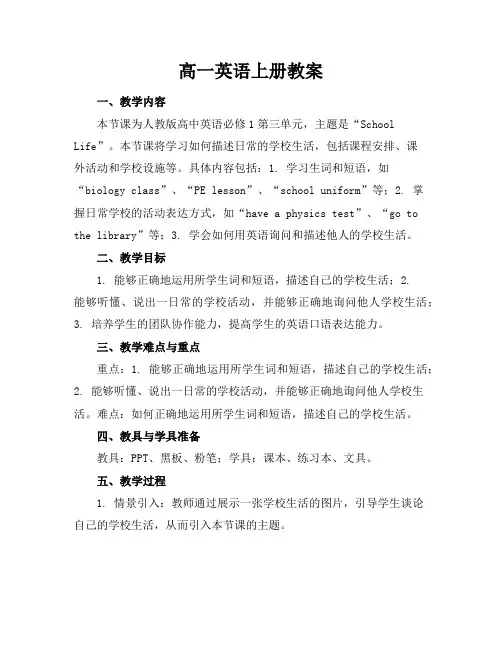
高一英语上册教案一、教学内容本节课为人教版高中英语必修1第三单元,主题是“School Life”。
本节课将学习如何描述日常的学校生活,包括课程安排、课外活动和学校设施等。
具体内容包括:1. 学习生词和短语,如“biology class”、“PE lesson”、“school uniform”等;2. 掌握日常学校的活动表达方式,如“have a physics test”、“go to the library”等;3. 学会如何用英语询问和描述他人的学校生活。
二、教学目标1. 能够正确地运用所学生词和短语,描述自己的学校生活;2.能够听懂、说出一日常的学校活动,并能够正确地询问他人学校生活;3. 培养学生的团队协作能力,提高学生的英语口语表达能力。
三、教学难点与重点重点:1. 能够正确地运用所学生词和短语,描述自己的学校生活;2. 能够听懂、说出一日常的学校活动,并能够正确地询问他人学校生活。
难点:如何正确地运用所学生词和短语,描述自己的学校生活。
四、教具与学具准备教具:PPT、黑板、粉笔;学具:课本、练习本、文具。
五、教学过程1. 情景引入:教师通过展示一张学校生活的图片,引导学生谈论自己的学校生活,从而引入本节课的主题。
2. 生词学习:教师引导学生跟读生词和短语,如“biology class”、“PE lesson”、“school uniform”等,并让学生用这些生词和短语造句。
3. 课文学习:教师引导学生跟读课文,让学生模仿语音语调,理解课文内容,并回答相关问题。
4. 活动展示:教师将学生分成小组,要求每组用英语展示一日常的学校活动,其他组的学生听后进行评价。
5. 课堂练习:教师设计一些练习题,如填空、选择题等,检查学生对课文内容的理解和掌握情况。
6. 作业布置:教师布置一些作业,如让学生写一篇关于自己学校生活的短文,并找两位同学进行互相批改。
六、板书设计板书设计如下:Unit 3 School Life1. 生词和短语:biology class, PE lesson, school uniform, have a physics test, go to the library等;2. 日常学校活动表达方式:have a biology class, go to the PE lesson, wear school uniform, take a test等;3. 询问和描述他人学校生活:What do you do in your school life? I have a biology class in the morning, and a PE lesson in the afternoon.七、作业设计答案:My School LifeMy school life is very interesting. I go to school every day at 8 o'clock. In the morning, I have math, Chinese andEnglish classes. In the afternoon, I have a PE lesson and a music class. After school, I often go to the library to read books or do my homework. I also join some clubs, like the soccer club and the art club. In my school, we have to wear school uniforms. I think my school life is fun and exciting.2. 题目:选择题。
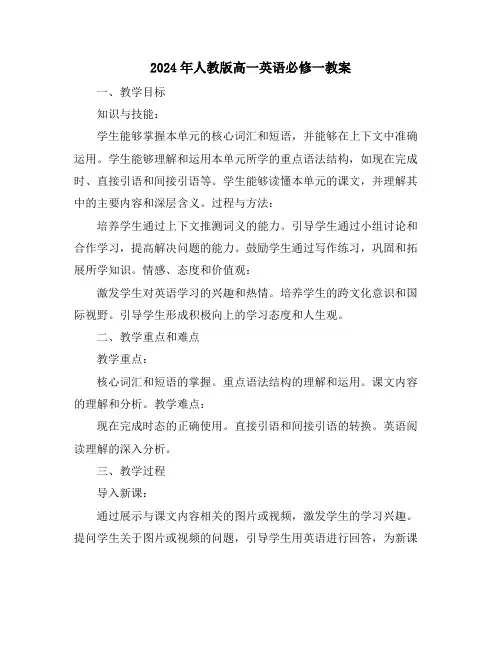
2024年人教版高一英语必修一教案一、教学目标知识与技能:学生能够掌握本单元的核心词汇和短语,并能够在上下文中准确运用。
学生能够理解和运用本单元所学的重点语法结构,如现在完成时、直接引语和间接引语等。
学生能够读懂本单元的课文,并理解其中的主要内容和深层含义。
过程与方法:培养学生通过上下文推测词义的能力。
引导学生通过小组讨论和合作学习,提高解决问题的能力。
鼓励学生通过写作练习,巩固和拓展所学知识。
情感、态度和价值观:激发学生对英语学习的兴趣和热情。
培养学生的跨文化意识和国际视野。
引导学生形成积极向上的学习态度和人生观。
二、教学重点和难点教学重点:核心词汇和短语的掌握。
重点语法结构的理解和运用。
课文内容的理解和分析。
教学难点:现在完成时态的正确使用。
直接引语和间接引语的转换。
英语阅读理解的深入分析。
三、教学过程导入新课:通过展示与课文内容相关的图片或视频,激发学生的学习兴趣。
提问学生关于图片或视频的问题,引导学生用英语进行回答,为新课做铺垫。
简要介绍本课的学习目标和重点,让学生明确学习任务。
词汇学习:呈现本课的重点词汇和短语,通过例句让学生理解其含义和用法。
组织学生进行词汇记忆游戏或竞赛,巩固所学词汇。
引导学生通过上下文推测词义,提高词汇运用能力。
语法讲解与练习:详细讲解本课的重点语法结构,如现在完成时、直接引语和间接引语等。
通过例句和练习让学生熟悉语法规则,并能够在实际语境中运用。
组织学生进行小组讨论,解决语法练习中的疑难问题。
课文学习:让学生快速阅读课文,了解大意。
分段讲解课文,解释重点和难点句子。
组织学生讨论课文内容,提炼中心思想,理解作者的观点和态度。
综合运用:设计一些综合性的练习,如完形填空、阅读理解等,检验学生对本课内容的掌握情况。
鼓励学生用英语复述课文,提高他们的口头表达能力。
组织学生编写与本课主题相关的短文或对话,培养他们的写作能力。
四、教学方法和手段教学方法:采用任务型教学法,让学生在完成任务的过程中主动学习和探索。
高一英语上册教案5篇1.高一英语上册教案篇一一、教学目标知识目标1. Get students to learn some useful new words and expressions in thispart.2. Get students to read the play.3. Let students learn the expressions of ordering food.能力目标1. Develop students’ reading skills and enable them to learn how to usedifferent reading strategies to read different reading materials.2. Enable students to understand and act out the play.3. Have students learn how to use the expressions to order food.情感目标1. Stimulate students’ interests of learning English by reading a nd actingthis play.2. Develop students’ sense of group cooperation and teamwork.二、教学重点1. Develop stud ents’ reading and speaking skills.2. Let students read and act the play.3. Have students learn to use the expressions to order food.三、教学难点1. Enable students to learn to use reading strategies such as skim ming,scanning, and so on.2. Get students to act the play.3. Have students make a dialogue at the restaurant.2.高一英语上册教案篇二Teaching ais:①.T read sectins f a str and sequence then use predictin strategi es and lining wrds.②.T use lining expressins related t tie and sequencing.③.T use wrdbuilding techniques t fr nuns, verbs, adectives and ad verbs.④.T tal abut and give pinins f fils.⑤. T practise using the secnd cnditinal fr speculatinTeaching difficult and ain pints:T aster the wrdbuilding.T use the lining wrds.Teaching aids:CAITeaching prcedures:Ⅰ. War upT l at a pictures f Titanic then raise a questin: .Have u seen the fil Titanic? Where did the str happen?Ⅱ. SpeaingWr in grups f fur t discuss the tw questins: Have u seen an ther f ils abut the sea? What did u thin f the? Tell ur classate.Ⅲ. Pre-readingL at the e wrds and find the in the pictures.Ⅳ. ReadingTas1: Nw please put Part A, B≈C in the crrect rder.We can put the paragraphs in rder accrding t (根据):the picturesthe lining wrds (连接词) :上下文相关词语的连接Tas2: Read the str again and answer these questins.1. Wh did the writer’s unger brther fall int the sea?2. Wh did the bat g twards the whirlpl?3. Wh did the writer tie hiself t a barrel?4. Wh didn’t his brt her d the sae?5. Wh did his ld friends nt recgnise hi?3.高一英语上册教案篇三一、教学内容分析本单元的中心话题是西方绘画艺术的历史和中西方各种艺术形式和风格。
第一册新教材高一教案UNIT第2课时一、教学目标1.知识目标:熟练掌握本课时生词和短语。
理解课文内容,能够分析课文结构。
学会运用课文中的语法知识进行句型转换。
2.能力目标:培养学生的听说读写能力,提高学生运用英语进行交际的能力。
培养学生合作学习的能力,提高学生自主学习的能力。
3.情感目标:培养学生热爱生活,关爱他人的品质。
培养学生团结协作,积极向上的精神风貌。
二、教学重难点1.教学重点:生词和短语的学习。
课文内容的理解。
语法知识的运用。
2.教学难点:课文结构的分析。
句型转换的技巧。
三、教学过程1.导入利用图片或视频导入本课时的话题,激发学生的兴趣。
2.生词学习帮助学生正确拼读和记忆生词。
通过游戏或活动让学生练习生词。
3.课文学习让学生先自主阅读课文,理解大意。
教师带领学生分析课文结构,梳理课文内容。
对课文中的难点进行讲解,帮助学生理解。
4.语法学习讲解课文中的语法知识,让学生掌握句型转换的技巧。
通过练习让学生巩固语法知识。
5.听说练习利用课文中的对话或情景,让学生进行听说练习。
鼓励学生运用所学语法知识进行交际。
6.写作练习让学生根据课文内容进行仿写或续写。
教师对学生的写作进行指导和评价。
7.小组活动将学生分成小组,进行课文内容的讨论或角色扮演。
鼓励学生在小组内积极发言,共同完成任务。
布置相关作业,让学生课后复习。
四、教学反思1.本课时教学过程中,学生的参与度较高,课堂气氛活跃。
3.语法知识的讲解和练习还有待加强,需要更多地关注学生的个体差异。
4.小组活动中,部分学生表现积极,但也有部分学生参与度不高,需要进一步引导。
五、教学资源1.教材:第一册新教材高一英语2.图片、视频等辅助教学材料3.语法练习题4.写作模板六、教学时间1课时七、教学评价1.课堂表现:观察学生在课堂上的参与度、发言积极性和合作学习情况。
2.作业完成情况:检查学生课后作业的完成质量,了解学生对课堂内容的掌握程度。
3.测试成绩:通过单元测试,了解学生对本课时内容的掌握情况。
新课标高一英语必修一全册教案教案一:Unit 1 Friendship教学目标:1. 了解并掌握本单元的重点词汇和短语。
2. 学会运用所学的语言知识,描述和谈论友谊。
3. 培养学生的阅读理解和口语表达能力。
教学重点:1. 重点词汇和短语的掌握和运用。
2. 阅读理解能力的培养。
教学难点:1. 如何正确运用所学的词汇和短语进行口语表达。
2. 如何理解并运用课文中的重点句子。
教学准备:1. 多媒体设备。
2. 教材和课件。
教学过程:Step 1:导入(5分钟)通过展示一些友谊的图片和问几个问题,引导学生进入话题。
- Do you have any good friends? How did you become friends?- What do you think makes a good friend?Step 2:词汇和短语学习(10分钟)通过多媒体展示和示范,教授本单元的重点词汇和短语。
- friendship, loyal, trust, support, companion, betray, argue, forgive, appreciate, value, make friends, keep in touch, get along with, fall out with, make upStep 3:阅读理解(20分钟)教师通过多媒体展示,让学生阅读课文,并进行理解。
- 学生阅读课文,并回答一些问题,如:What is the main idea of the passage? What does the author think about friendship? How does the author describe a good friend?Step 4:语言运用(15分钟)通过讨论和练习,让学生运用所学的语言知识进行口语表达。
- 讨论题目:What qualities do you think a good friend should have? Give examples to support your ideas.- 练习:学生分组进行角色扮演,模拟对话中的情景。
高一英语必修一教案通过学习这篇课文,使学生感悟到科学家的周密观察、勇于探索、认真分析的科学精神,使学生了解到科学发现的全过程具有其科学的严密性。
该课文出现了英语重要语法知识--过去分词的用法。
一起看看高一英语必修一教案!欢迎查阅!英语必修一教案1一、说教材1、材的地位和内容该课文John Snow Defeats King Cholera 是人教版高中英语必修5第一单元的一篇文章,这是一篇阅读课。
文章介绍了有名医生John Snow 是如何通过考察、分析和探究的科学方法,发现并控制“霍乱”这种传染疾病的。
通过学习这篇课文,使学生感悟到科学家的周密观察、勇于探索、认真分析的科学精神,使学生了解到科学发现的全过程具有其科学的严密性。
该课文出现了英语重要语法知识--过去分词的用法。
2、教学目标根据该教材的特点以及高中英语课程标准,我拟定下列教学目标1) 语言知识目标词汇:defeat attend expose cure outbreak control absorb severe valuable strict pump 等语法:过去分词作定语和表语2) 语言技能目标练习并培养学生的听、说、读和写的能力,侧重培养和提高学生的阅读理解能力3) 情感目标培养学生的科学探索精神,培养学生科学人文精神相融合的素养4) 学习策略目标学生通过阅读理解、互动交流以及完成任务过程中进行有效地自我调控,通过各种途径获取相关信息,并运用有效教学资源5) 文化意识目标3、学重点和难点重点:理解所读课文;把握过去分词的用法难点:利用所学词汇、句型,围绕主题进行叙述二、说教法根据高中英语课程标准,根据“整体语言教学”的理论和实践,以及当前教学改革的新理念,为达成上述的教学目标,运用“任务型”英语教学法。
在实际的教学活动中,充分体现教师在教学活动中的主导、组织和监控的作用。
充分发挥学生在教学活动中的主观能动性。
以学生为中心,开展自主性学习活动,促使学生通过探究、独立思考以及合作学习的方式,完成学习任务。
高一英语教案精选6篇高一英语教案精选6篇高一英语教案1 一、利用表象,丰富想象观察图画和实物作文符合英语作文起步阶段需要有一定的情景要求,也符合高中学生有意想象占优势的特点,同时防止了文字情节作文易使学生中译英的缺点,但假设每一次训练都是刻板的再现材料,创造想象那么难以增长。
假设在教学设计时,在图中留有空白,或对实物设置悬念,不仅可以引发学生的好奇心,激发他们对英语作文的兴趣,减轻他们的惧怕心理,而且可以促使学生通过创造性的想象去填补空白,解决悬念。
如senior bookⅰ,unit 3 中的“help! help!”,可按开展顺序设计几幅救落水儿童的图,但只给学生展示第一、二两幅图,图画的内容大致与课文内容一样,但是后几幅的空白,使学生必须通过创造性的想象才能填补材料的空白。
学生可以引用课文中的材料,也可以自由发挥。
有学生这样写到:last week, we had a picnic in forest park。
we found a shady place by the river。
as soon as we had sat down, tom suddenly got up and shouted,“someonehas fallen into the river!" it was true。
a boy was struggling in the water, and the children in a boat looked hopeless。
tom and jack took off their shoes while running to wards the water。
they swam very quickly towards the boy who was sinking fast。
tom and jack got hold of the boy by the arms and lifted his head above the water。
最新人教版高一Unit 1教案(人教版高一英语上册教案教学设计)I Teaching Aims and Demands1.Words and expressions1)wordshonest; brave; loyal; wise; handsome ;smart; argue; solution; classical; Joe; match;mirror;gun;hammer;saw;rope;compass;movie;cast;TomHa nks;ChuckNoland;survive;deserted;hare;sorrow;feeling;boardjairplane;parachute;lie;sp eech;adventure; notebook; scared; e-pal ;Carolina; admit ;opinion 2)useful expressionsbe fond of ;treat…as…; make friends with ;hunt for; in order to; share…with2.Oral demandTalk about friend and friendship in English3. Grammar1)the indirect speech led by if/what /who/where/how…2)review the usage of nouns and articles4. Written demandwrite an E-mail about friendship5.Moral demandTeach the Ss how to get on well with friends and treasure friendship.II Teaching methodCo-orperating teachongIII Study methodSelf-study guided by the teacherIV Teaching aidsComputer,tape recorder,slide shoe,etc.V Teaching stepsPeriod 1Step 1 1. Ask the Ss the following questions to review some Warming up words they know to describe their friends:1) Do you have good friends?2) What do you think of them? / Why do you think he / she is your good friend?3) What kind of people do you want them to be your friends ?4) Are there any other words we can use to describe a friend?2. Review and learn some useful words:Appearance:tall short thin fat strong slim beautiful pretty handsome(attractive, fair) smart (quick, bright)Qualities:kind kind-hearted / warm-hearted politehelpful gentle noblehonest trustworthy frank openheartedbrave great full of courage / courageousloyal true faithful to a friend dependablewise clever bright learned3. Ask the Ss to use the following sentences to describe themselves or their friends, first practise in pairs, then the whole class.1) I think I am ______, ______ and _______.I think I am ________ because I ________. So when you ______, you can _______.2) I think he / she is _______, _______ and ________.I think he / she is _______ because __________.4. Go over Part 2 on Page 87. Ask the Ss to make sentencesas the example.Step 2 1. Listen to the tape and finish the three situations one Listening by one. Then ask the Ss to check the answers with their partners.2. Go over Part 1 in Listening on Page 85.3. Go over Part 2 in Listening on Page 85.Step 3 Written work: Part 2 on Page 87 in the exercise book.Homework Reading: Go over Speaking Part on Page 2 and finishthe table on Page 3.SummaryPeriod 2Step1 1. Ask the Ss to tell what they learned in the last period Revision and their opinions about what a good friend should be.2. Ask the Ss to tell if there was anything unhappy that once happened between them and their friends and how did they solved it.Step 2 1. Ask the Ss to go over Part 1 in Talking on Page 85, Talking first in pairs, then in class.2. Let the Ss say what patterns we can use to makeapologies.You said that you would … Why did / didn’t you …?You promised to … Why didn’t you…?Please forgive me.I’m very sorry. …It won’t happen again.I’m sorry I forgot.3. Go over Part 2 on Page 86, first in pairs and thenwith the whole class.4. Go over Part 3. First ask the Ss to complete the rolecards in pairs. Then check some cards in class. And then ask the Ss to work in pairs to act out.Step 3 1. Go over Speaking part on Page 2 by checking the Speaking list. First ask some Ss to read this part. Then check The answers to the list.2. Ask the Ss which of the six students they want tomake friends with and why.3. Ask the Ss to discuss in groups of four: Are friendsvery important in our life? Why?Ask some groups to report the result of their discussion.Step 4 Written work: Part 3 on Page 87.Homework Reading: Many-flavoured friends on Pages 88-89, and answer the questions.SummaryPeriod 3Step 1 1. Suppose you are alone on a deserted (empty, no onePre-reading lives there) island. You have to survive (remain alive, try not to die) without friends and all the things you use in your everyday life. Which of the items (things, articles) in the box would be the most useful to you on the island? List three most useful items and explain why you think they would be useful.2. Ask the Ss to discuss their answers in groups of four and then ask some of them to report their answers.3. Talk about the movie post of CAST AWAY.Step 2 Ask the Ss to read the passage and find the answers Reading to the questions:1) What is the movie about?2) Who is Chuck?3) What happens to Chuck one day when he is flying acrossthe Pacific Ocean?4) How many years has he spent on the deserted island?5) What becomes his best friend there? Why?Step 3 1. Ask the Ss to find the answers to the first threePost-reading questions in Post-reading part.2. Ask the Ss to discuss the fourth one in groups of four, and then report to the whole class.Step 4 Check the answers to the reading material on pages Workbook 88~89.Step 5 1. Listen to and read the text again and again.Homework 2. Find out the difficult sentences and go over the notes to this text.3. Look up the word learn in the dictionary and try tofind out different meanings of it.SummaryPeriod 4Step 1 1. Ask the Ss to tell what they have learned from the Review text.2. Ask some of the Ss to read the text paragraph byparagraph and paragraph. And at the same time ask them to point out the sentences they don’t understand.Step 2 1. Ask the Ss to find out the following phrases in the Paraphrasing text:on a deserted island, hunt for food, make a fire,be alone on the island, become / be fond of …, treat sb as…, share happiness and sorrow, make friends with …2. Ask the Ss to make sentences with hunt for, be fond of, treat ab as …3. Ask the Ss to put the follow sentences into Chinese.1) Chuck is a businessman who is always so busy that he haslittle time for his friends.2) One day Chuck is on a flight across the Pacific Ocean when suddenly his plane crashes.3) Perhaps the most difficult challenge is how to survive without friends.4) In order to survive, Chuck develops a friendship with an unusual friend - a volleyball he calls Wilson.5) … it is important to have someone to care about.6) He also learns that he should have cared more about his friends.7)… we must give as muc h as we take.8) The lesson we can learn from Chuck and all the others who have unusual friends is that friends are teachers.Step 3 Ask the Ss to think over and answer the question:Discussing 1) How can a volleyball become Chuck’s friend?2) The text talks about giving and taking. How do you and your friends give and take?3) Does a successful man or woman need friends? Why or why not?4) What do friends teach us?5) Is it better to have a human friend or an unusual friend such as a volleyball, a pen or a dog?Step 4 The usage of learn:Word study 1. To gain knowledge or skill by study, experience orbeing taughtlearn a foreign languageWe’re learning English now.Have you learned how to drive a car?One can learn from his mistakes.2. fix in the mind or memory; memorizeLet’s try to learn the poem by heart.3. realize; become awareThey learned that it was no use arguing with him.4. know, get to knowThey offered help as soon as they learned that we were in great trouble.I learned of the accident only yesterday.learn one’s lesson; learn a lesson from sblearned a learned teacherStep 5 Go over Part 1 in Vocabulary on Page 87.Listening First go over all the words and ask some students to tell what these words mean and when we’ll use these words. Then listen to the tape and finish this exercise.Step 6 1. Finish Word Study on Pages 4~5.Homework 2. Go over the Grammar part on Page 5. Try to find out the difference between Direct Speech and Indirect Speech in statements and questions.SummaryPeriod 5Step 1 Go over this part by asking some Ss to read the ten Word study sentences one by one to check the answers.Step 2 1. Ask the Ss to discuss the difference between Direct Grammar Speech and Indirect Speech in pairs.2. Summary:In Statements“I like reading adventure stories,” said John.John said (that) he liked reading adventure stories.“I don’t like computers,” Sarah said to her friends.Sarah told her friends (that) she didn’t like computers.In General Questions:“Ann, have you see my blue notebook?” Peter asked.Peter asked Ann if she had seen his blue notebook.In Special Questions:“How can you do that?” Mary asked Ann.Mary asked Ann how she could do that.“What difference does it make?” Peter asked Jim.Peter asked Jim what difference it made.3. Go over Part 1 on Page 5.4. Go over Part 2 on Page 6.Step 3 1. Go over Part 2 on Page 88.Workbook 2. Go over Part 3 on Page 88 first in pairs, and thencheck with the whole class.3. Go over Part 1 by asking some Ss to write downtheir sentences on the Bb.Step 4 1. Review the reading material.Homework 2. Finish all the exercises about the Grammar in this unit. And go over Parts 1 and 2 on Pages 177~180.3. Ask the Ss to think about in what ways we can make friends with others.SummaryPeriod 6Step 1 Ask the Ss some questions and let some Ss report Revision these questions:1) Do you want to study English? Why?2) Why do you think English is very important?3) What do you think a good friend should be?4) Do you have any good friends?5) How can we make friends with others?6) Would you like to say something about one of your friends?7) What do you often do together with your friends?8) What do you think are good ways to make friends with a stranger?9) Do you know how to make a pen friend or a pen pal?10) Can we use the Internet to make friends? How to use it to make friends?Step 2 1. Read the short passage on Page 6 and tell the main Reading and idea of it.Writing Questions:1) What is a pen friend or pen pal?2) What is an e-pal or key pal?3) What is the advantage of e-mail?2. Read the two e-pal ads and tell what kinds ofpeople do you think they are.Jane: funny, humour, frank, openhearted, friendlyJack: friendly, funny, humour, openhearted, honest3. Go over the tips and then write an e-mail message.And then check each other’s message with thepartner.Step 3 1. Read the e-mail on Page 90 and tell what it is about.Workbook 2. Talk about how to write a response.Step 4 1. Go over Checkpoint 1.Checkpoint 2. Ask the Ss to think about what they have learned inthis unit.Step 5 1. Go over Learner Log on Page 90 to make sure that Assessing the Ss know what it means and how to fill in the table correctly.2. Go over Reflection and ask the Ss to finish thesentences.Step 6 1. Review the whole unit.Homework 2. Write an e-mail to introduce yourself to an e-pal and send it to the teacher’s e-mail box.SummaryPeriod 7Step 1 1. Dictate the following passage and then choose a Dictation title for it.Pal Restaurant is one of the many restaurants where people come to eat, drink, talk and enjoy music. It is different from other restaurants because its owners are a group of college students.1. ….But 2. …. “We can’t stop them but we want them to put study in the first place.” Teachers do not supp ort them, either.3. ….4. ….5. ….6. ….But Lin Tao says they are doing OK.Title: Students Running BarStudy First or BUSINESS First?2. Some words and phrases in the listening text:solve a problem / problems, common problem,get mad, communicate, in a different way,deal with, apologize, apology, keep a secret,in a difficult situation,rumour 谣[流]言, 传闻The rumo(u)r has turned out to be true.这谣传结果是真的。
Unit 9 Technology一.教材解读(Material Interpretation)通常人们忌讳“只见树木,不见森林”,然而这里我们姑且就一个单元这只林片木来想象一下那片充满神奇的森林。
从某种意义上说,这或许正是这套教材的编写者们的用意所在。
高一英语新教材的编写依然以单元为单位,但每个单元打破了呆板的块状设计,换之于流畅的线型流程,为课堂教学的灵活组织留下了更大的空间。
整个教材体现了Communicative Curriculum的指导思想。
每个单元以功能为主题,话题为支撑,结构为平台,任务为载体,意义交流为目的,充分体现了语言运用的基本思路,为任务型课堂教学构建了框架,注重提高学生用英语获取信息、处理信息、分析和解决问题的能力,发展学生与人沟通和合作的能力。
本单元的主题是Technology,中心话题为Hi-tech,话题本身具有强烈的时代气息,贴近学生的实际生活,符合学生的认知水平,在学生中有较强的认同感。
这一单元的交际功能项目(Functional Item)有两个:1. Describing things 2. Expressing agreement & disagreement。
结构项目(Structure)为The Present Continuous Passive Voice;主要能力项目为Reading 和Writing,其中一个阅读正篇,两个Language Input, 要求学生学会阅读并在阅读中培养根据上下文或构词法理判断词义的能力,同时学会写信并在信中阐述问题的症结,发表自己的观点。
拓展项目为如何运用高科技获取更多英语信息,提升英语学习,并探究科技为人类带来便利的同时可能存在的负面影响以及消除这些影响的解决办法。
二教学目标(Instructional Objectives)通过教学,学生能描绘一些日常用品(如第一课时的A Guessing Game 和Describing and Drawing),发现一些问题,发表个人观点,努力解决问题(如第二课时的Problems and Solutions,Role Play和A TV Chitchat Program: Help is on the Way);能学会与他人交流和合作(如第三课时中的Designing and advertising a new model of cell phone for Chinese high school students);能学会寻找适当渠道解决实际问题(如第四课时中的A Letter of Complaint to the Headmaster);能自己学会学习,在学习中建立输入假设,在实践中验证假设,并最后修正假设(如第四课时的对The Present Continuous Passive Voice的学习);能懂得基本的一些学习策略,并运用这些策略提高在一定的context 中对一些较难词义的推断能力(如第五课时中的Word and Strategy);能运用高科技获取更多英语信息,提升自己的英语学习(如第三课时中的Story Sharing和第六课时的Essay Writing);能探究高科技为人类带来文明和便利的同时可能存在的负面影响以及消除这些影响的解决办法(如第五课时中的Talk about the advantages and disadvantages of cellphones, robots, computers etc.);能在研究性的学习中进行自我反思,培养公民意识、社会责任感和全球观念(如第五课时中的 A Probe into the Cause of T eenagers’ Addiction to Cyber Café和第六课时中的To Be a Technology-driven Human or not to Be);能在不断的反思中领悟并懂得人类追求高科技的根本目的,倡导人与人之间的友爱和真情(如第六课时中的写给未来控制了人类的巨能电脑Q12 的题为Love is the Everlasting Topic of the World的信)。
三.教学设想(Teaching Assumptions)在整个单元的教学中我们突出以话题为纲,交际功能为主线,兼顾结构,适当拓展。
在教学方法上坚持以Communicative Approach 为主,辅以其他多种有效教学方法。
充分运用任务型教学途径,精心设计各种任务,以任务为载体,搭建意义交流舞台,创设各种情景途径,创建各种情感体验机会。
通过教学,进一步发展学生基本语言运用能力,激活学生的英语思维,保持英语的学习热情,使精心设定的Moral Goal 的完成能水到渠成。
例如,提高用英语获取信息、处理信息、分析和解决问题的能力,发展学生与人沟通和合作的能力;激发学生对事物深入了解的探究心理,逐步养成研究性学习意识; 通过自主学习和社会调查,和与发展国家在科技方面的比较,了解社会,增强社会责任感((Social Responsibility),强化祖国意识(National Awareness),培养全球观念(Global Sense)。
1.话题拓展(Extended Topics)以Technology为主题,由中心话题衍生出六个Sub Topics, 分别是New Uses of Things, Problems and Solutions, Life in a Technological Era, Teaching & Living Facilities of the School, Controversy about Technology 和Attitude towards Technology。
根据每一个Sub Topic 精心设计相应的任务,突出交际功能,通过完成任务使学生达到交流的目的,完成语言的运用,能力要求涵盖听、说、读、写及综合运用,人文因素涉及学生的情感态度、学习策略、文化意识、价值取向和评判标准。
所有的Sub Topics 均指向中心话题,在单元的结束提升主题:Love is the Everlasting Topic of the World。
2.课时设计(Time Allocation)和阶段教学目标(Phase Teaching Demands)整个单元拟用五个课时完成,每个课时由一个Sub Topic 展开,功能项目明确,任务真实具体,能力取向明朗。
3.教学思路(Teaching Planning)和任务设计(Task Designing) 整个单元分成六个次话题:New Uses of Things, Problems and Solutions, Life in a Technological Era, Teaching and Living Facilities, Controversy about Technology 和Attitude towards Technology,根据难点重点设计任务,注意任务的连贯性、剃度性。
第一课时话题为New Uses of Things, 能力重点为Listening。
在设计任务时特地设计了Describe the things and how they work, 突出Listening外,巧妙地融进了Speaking , 为下一课时作好了铺垫。
在做Describing and Drawing任务时,老师有意识地用一些如CD机,遥控器之类的东西,让一组学生进行Description,另一组学生进行Drawing and Guessing, 这样成功地创造了一个Information Gap,使学生兴致盎然,并在完成任务的同时悄悄地接近了单元中心主题。
教学者就这样不露痕迹地完成点题这一细节。
结束任务是除了本节课探讨的这些东西的New Uses 以外,思考一下使用这些东西带来的问题。
这样巧妙地过渡到了第二课时的话题Problems and Solutions。
第二课时话题为Problems and Solutions,能力重点是Speaking。
通过Warming up 和对上一节课布置的问题的思考,轻松引入Speaking。
通过帮助老师解决难题这一任务, 预演怎么Give opinions, 如何express agreement and disagreement。
接着,进入Role Play 这一任务。
通过观看Family Album, USA,和Mr Bean中的几组镜头,学会更多表示同意和反对的方法,拓展语汇,丰满语言。
此后学生开始由外及里,进入每人的内心世界,审视自身的问题,寻求解决的途径。
最后通过模拟电视台主持人主持的一档题为Puppy Love 的Chitchat Program,让学生模拟老师、家长、校长、专家、教育部门领导等角色,畅所欲言,以进一步巩固已学语言,达到真实交流的目的。
结束时一个What Makes Such Service Possible?又将学生引入中心话题Technology的思索.。
要求学生在思索之后通过上网阅读,准备一个能体现Technology优越性的爱心故事,在下一节课与其他同学分享。
这以环节不仅与下一节课的主题Life in a Technological Era联系了起来,为下一节阅读课作了准备,更为本单元最后主题的升华即Love is the Everlasting Topic of the World 埋下了伏笔。
第三课时为Reading, Sub Topic为Life in a Technological Era。
通过Story Sharing这一“读中带说”的任务,感悟Technology,畅谈由此带来的便利和文明的提高。
接着转入阅读,依次完成阅读的各级任务,同时初步领略语言项目The Present Continuous Passive Voice,为下一节课作好铺垫。
最后,从感受高科技进入体验高科技,完成一个Cell Phone新款的设计任务,并用恰当语言表述其性能、款式,完成产品的宣传策划,接着根据市场反馈,修正设计任务。
这节课的Assignment是一个关于学校教学和学生生活设施的一个调查。
学生五、六人不等,组成一个小组,完成对学校现有教学和生活设施的调查,明确在这方面还应该有哪些投入,紧扣下一节的话题,并为在下一节课模拟和校长的Interview中和写给校长的A Letter of Complaint中准备好真实的材料。
第四课时的话题为Teaching and Living Facilities。